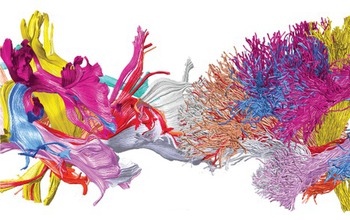Multimedia Gallery
Researchers are working to develop methods to capture, harmonize and share neuroscience data.
The image shows two brain connectomes identified in a human brain using different methods for mapping human white matter in vivo. Colors show major white matter tracts. These tracts are the most prominent edges of the human connectome -- highways of communication that allows distant parts of the brain to communicate. The image exemplifies modern computational methods and technologies for mapping the human brain. Modern neuroscience methods can study the human brain at unprecedented resolution and generate large and diverse datasets with the potential to enrich our understanding of the most basic functioning of the human brain. The most modern methods are allowing investigators to generate petabytes of brain mapping data like the ones in the figure. Future challenges for the community involve moving neuroscience toward big data and data science and developing methods to capture, harmonize and make all these data available to communities of researchers. To approach this challenge the community of scientists will need to bridge the infrastructure gaps between the multiple centers where data are collected across the nation and provide means of communication between the data and the national high-performance computing resources.
Credit: Franco Pestilli, Indiana Unversity in collaboration with Mike Jackson Indiana University
Images credited to the National Science Foundation, a federal agency, are in the public domain. The images were created by employees of the United States Government as part of their official duties or prepared by contractors as "works for hire" for NSF. You may freely use NSF-credited images and, at your discretion, credit NSF with a "Courtesy: National Science Foundation" notation.
Additional information about general usage can be found in Conditions.
Also Available:
Download the high-resolution PNG version of the image. (360.0 KB)
Use your mouse to right-click (Mac users may need to Ctrl-click) the link above and choose the option that will save the file or target to your computer.
Related story: Connecting data scientists with regional challenges



